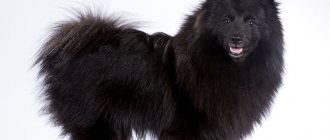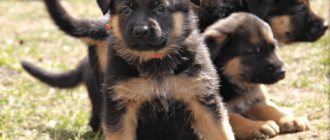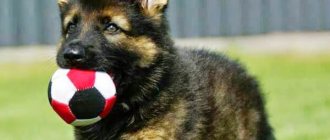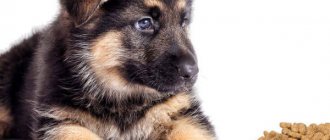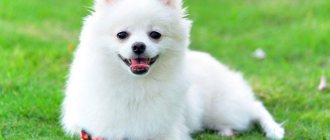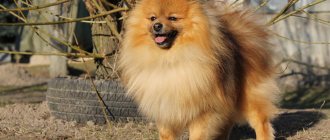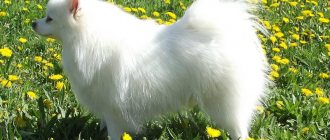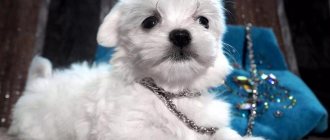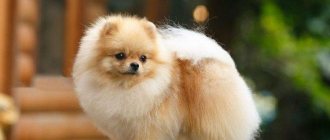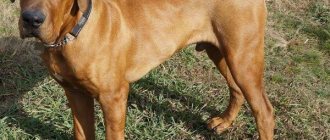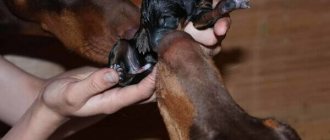Author of the article: Dmitry Boyko | Updated: 09/14/2020
The Miniature Spitz is the smallest dog among the decorative breeds. The prefix “zwerg” means miniature, or dwarf, which most accurately characterizes the description of the breed. The tiny Spitz, also called the Pomeranian, is a variety of the German Spitz, although some canine organizations classify it as a separate breed. Where did a dog with such a cute, almost fairy-tale appearance come from, and how demanding is he in terms of living conditions?
Description and characteristics of the Miniature Spitz breed
Miniature dogs are the smallest of decorative dogs. There is still debate among dog handlers as to whether they belong to the same breed as Spitz or not. Most give an affirmative answer: the German Miniature Spitz is a small Pomeranian.
What does it look like
Externally, the miniature Miniature Spitz resembles a soft toy. He has thick, fluffy fur and is short in stature. According to the standard, the dog should look like a small fox, although there are other varieties - “bear cub” and “toy”. The most popular is the bear type, its main difference being small ears and a slightly flattened nose. The exterior of the intermediate version (“toy” or “baby dollar”) was developed in Japan. Sometimes a bear-type Pomeranian is obtained not as a result of selection, but thanks to the skillful hands of a groomer.
Breed standards
According to the standard, the breed has the following characteristics:
- the body is square with a tucked belly and a developed chest;
- the back and lower back are straight, the withers are weakly expressed;
- the skull is wide, the muzzle is narrow, the transition from the forehead is clear;
- nose black or brown;
- the eyes are almond-shaped, slightly slanted;
- the ears are triangular with sharp tips, set high;
- small teeth, scissor bite;
- the tail is high, fluffy, in the shape of a half ring;
- the limbs are straight, the paws are small, reminiscent of a cat;
- The coat is two-layered with a voluminous undercoat and a vertical guard.
Weight and height of an adult dog
The Zwergspitz is a dwarf representative of the breed. In adulthood, the minimum height of a dog at the withers is 18 cm, the maximum is 22 cm. Weight does not exceed 3.2 kg.
Character and behavior
The character of the Dwarf Spitz does not match its appearance. A small dog is capable of selflessly protecting the home and owner, and showing aggression towards other animals. She may be jealous of a person because she is strongly attached to him and does not like to be alone for a long time. If she feels that little attention is being paid to her, she begins to do harm - she chews furniture and spoils things.
Zwegers love noisy fun and walks. Even in adulthood, they remain active, mischievous, and try to attract maximum attention to themselves.
Coat colors
There is a huge variety of Zweger colors, about sixteen in total. The most popular are red, brown, cream, white, black and others. It is impossible to tell from the fur of newly born puppies what color it will be. Only after the first molt, at the age of six months, the pet’s true color is determined.
Brown
The rich brown color, evenly distributed over the entire surface of the coat, looks like chocolate. According to the standard, it is allowed for the nose, lips and eyelids of such dogs to match the overall tone. This is explained by the fact that the skin of chocolate Spitz dogs does not produce melanin.
Sable
The sable color is composed of two tones - a light undercoat and dark tips of the guard hairs. The intensity differs in different areas. Standard suit:
- gray;
- redhead;
- orange;
- creamy
A dark muzzle in the form of a mask is allowed.
Black
Coal black color implies the absence of any transitions or shades. The entire dog should be completely black, including the skin, nose and paw pads. A distinctive feature of this Spitz is the constantly smiling expression on its face.
Black and tan
The color can be light or slightly blackened. Over time it becomes brighter, inclusions of various shades appear. The black Spitz has brown tan marks. Markings are located on the paws and chest.
White
According to the standard, a white Miniature Spitz must be absolutely pure, without any impurities of another color. Only two white parents produce such offspring. The presence of colored ancestors in the family can result in the birth of puppies that, after molting, turn into cream ones.
Ginger
Red or orange miniatures are the most popular among dog breeders. Dwarf Pomeranians are similar to foxes; their coats do not have to be uniform. Local lightening is possible in the area of the muzzle, paws and under the tail.
Spotted
The color consists of a basic white background, black and brown spots throughout the body. It is especially appreciated if they are located symmetrically, and there is a white mark on the head. Disadvantages are considered to be the “raincoat” color, lack of spots, and specks on the paws and face.
Party color
The color involves two coat colors, of which the main one is white. It has symmetrical markings. There are three types of party colors:
- Irish – there is less white background than spots;
- piebald – markings are evenly spaced throughout the body;
- extreme piebald - more white than bright spots.
brindle
One of the most beautiful is the miniature brindle-colored miniature spitz. Its distinctive feature is alternately arranged black, brown or orange stripes. The suit is characterized by a dark mask on the face, rings on the paws and tail.
Cream
The cream color looks very delicate. There are several shades - some of them are more, others are less saturated. The first ones are warm, the second ones are cold, close to white.
Blue
The rarest and most spectacular color. There are varieties - merle and marble. Zweger looks especially impressive with blue eyes. Dogs of this color are considered the result of a gene mutation, but their price on the market is very high.
Zone gray
Because of its resemblance to a predator, the zone-gray is called wolf-like. According to the standard, the coat should be gray with black tips of the guard hairs. The ears, muzzle, end of the tail and the outline around the eyes are also dark. The shoulders and mane are light, and the legs are silver without the presence of black spots.
History of appearance
The common ancestor of all Spitz breeds was the turf dog, which lived back in the Stone Age. Already in the Middle Ages, the appearance of dogs with the features of modern Spitz was noted. Purposeful breeding was carried out in Germany, but the Miniature Spitz received its size and appearance thanks to the British.
It was British dog handlers who were able to reduce the size of the dog. If at the beginning of their work dogs weighing 15-18 kg were considered dwarf, then in 1891 the English Pomeranian Spitz Club approved a distinction by weight: for dwarf Spitz - 2.5 - 3.6 kg, and for small Spitz - over 3.6 kg .
And in the 10s of the twentieth century, in the same club, Pomeranian Spitz were identified as a separate breed and presented at the exhibition. At the same time, the breed was recognized by American dog handlers and admitted to exhibitions.
Did you know? The popularity of Miniature Spitz dogs in the British Empire is due to Queen Victoria’s love for them. She brought her Spitz Marco from Venice. And her second favorite, the Spitz Turi, was with his mistress on her deathbed.
Rules for the care and maintenance of a mini German miniature spitz
In order for a dwarf German Spitz to develop successfully and be healthy, it needs to be provided with proper care. Do not allow the wool to become matted or tangles to form. It is necessary to accustom him to walking and to the tray in a timely manner. By organizing proper and regular nutrition, it is logical to expect that the puppy will grow up healthy and strong. Training and education are no less important.
Diet
After weaning from its mother, the Miniature Spitz is accustomed to a new regime and diet. They switch to unfamiliar foods gradually and carefully, observing the reaction of the puppy’s body to food.
The diet of a dwarf Spitz should include:
- beef, veal;
- boiled fish without bones;
- buckwheat and rice porridge;
- vegetables;
- eggs;
- fruits.
You can give your miniature dog ready-made dry food, choosing high-quality, super-premium food designed for small breeds. It is necessary to follow the manufacturer's recommendations regarding serving size so that mini Spitz dogs with their insatiable appetite do not gain excess weight.
Walking outside
The Miniature Spitz is taken outside after vaccinations and quarantine. At first the walk lasts 10-15 minutes. The time is gradually increased and brought to 1-2 hours. The dwarf Spitz is walked on a leash, released only in a safe place where there are no highways, large dogs, construction sites or other dangers nearby.
Grooming and grooming
To keep your Miniature Spitz in perfect order, trimming is performed weekly - plucking out lost hairs. Particular attention is paid to the ears - the fur is carefully trimmed along the contour. The tail is left fluffy, the base is slightly thinned out so that it is convenient to throw it on the back. The paws are shaped with scissors around the circumference. The hair between the toes and near the anus is trimmed. During the molting period, the animal is combed especially carefully. They bathe when soiled, but not more than once every two months.
Care for eyes, claws, ears
Once or twice a week, the Miniature Spitz's eyes and ears are wiped with cotton swabs soaked in a special lotion or chamomile infusion. Claws are trimmed as needed, since during walks they naturally wear down on hard stones. A nail clipper is used for the procedure.
Diseases, life expectancy
Miniature Spitz dogs have good health. Among the pathologies to which the breed is most susceptible:
- dislocation of the kneecap and joints;
- complicated childbirth;
- bulging eyes;
- cataract;
- periodontal disease;
- tracheal collapse.
With careful attention to the health of pets, they live a long time. The average duration is 13-14 years.
Raising and training a dog
The Miniature Spitz has a high learning ability - it is enough to repeat the command several times for the dog to understand and begin to carry it out. The training process is organized so that it is consistent and persistent. You cannot give the dog any concessions and the opportunity to take over the owner.
During upbringing, difficulties may arise due to the willfulness and stubbornness of representatives of the breed. At this moment, he is made to understand who is in charge in the house and who must obey unquestioningly.
Family life, relationships with children
The Zwergspitz easily finds a common language with all family members, but experiences the strongest and most sincere feelings for its owner. He does not show aggression towards children, he may mistake other animals for danger and will rush to defend himself. The German Dwarf Spitz becomes a companion for everyone.
If you explain to the Pomeranian that the people who came to the house are not strangers, he does not bark, but begins to joyfully jump and have fun, which always attracts the attention of others.
Character
The Spitz's character is soft, playful, cheerful and kind. These merry fellows always make their neighbors happy, running and jumping around carefree. They become strongly attached to their owner (example Queen Victoria), do not know life without him and become reliable friends to everyone around their owner.
They are good-natured with children, they can play and spend time with them.
Leave this sweet little bundle of kindness alone with your child - nothing bad will happen.
The miniature needs constant training of mind and body. Dog handlers advise playing with him more and giving him various commands to keep him in good shape.
Despite its small size, the dog needs daily exercise
Flaws
First of all, they bark for no reason. This barking cannot be stopped. If you start to show aggression, it will increase in duration.
Secondly, they are completely unaware of their size. German Miniature Spitz attacks other dogs, even if the latter are much larger than them. Just keep her away from other large dogs and keep your Pomeranian under control. Remember, this should not irritate, but rather flatter, because the little protector is ready to do anything for the sake of his owner.
Advantages and disadvantages of the German Miniature Spitz
Zwegers or dwarf Spitz dogs have their own advantages and disadvantages as a breed. Among the advantages:
- mischievous disposition;
- boundless devotion to the owner;
- activity;
- attractive appearance;
- thick beautiful wool;
- tolerance to low temperatures;
- good health;
- long life expectancy;
- unpretentiousness in care and food.
Minuses:
- fear of loneliness;
- manifestations of jealousy;
- tendency to bark for a long time, distrust of strangers;
- frequent fractures and dislocations;
- malocclusion;
- deformation of the nasopharynx due to a shortened muzzle.
Upbringing
The mini Pomeranian is smart, quick-witted, remembers commands, and does complex tricks like seeds.
But there are a lot of ill-mannered Pomeranians. What is the reason? The fact is that owners of decorative breeds consider small dogs not dangerous. This means there is no need to deal with them. The result is an unbalanced Miniature Spitz, who feels like he is the head of the family and almost the center of the Universe.
This position is dangerous. The mini-Spitz doesn't look scary. But any dog is a bladed weapon. A bitter orange bite hurts, it can tear muscles and bite through veins. Not to mention the fact that an ill-mannered miniature spitz ruins the nerves of its owners and those around them.
Pomeranian puppies should be taught discipline from the first minutes in their new home. The rules are set once and for all. Up to 4 months, the Pomeranian is simply raised, and then commands from the main training course are introduced.
Training the Miniature Spitz is complicated by its tendency to be stubborn and manipulative. Plus, pets have a delicate, easily excitable nervous system. Therefore, you need to find a balance between hardness and softness, to be an affectionate, loving, but demanding owner who is not forgiving of antics.
The main skills that a miniature Spitz must learn, in addition to OKD, are the ability to remain alone and not bark in vain. Any causeless barking is stopped at the first yelp, and they are gradually accustomed to loneliness, leaving the Miniature Spitz at first for a couple of minutes, gradually increasing the time to several hours.
Where can I buy a Miniature Spitz puppy, prices
To buy a purebred Miniature Spitz, you should contact trusted nurseries that breed the breed. The most famous among them:
- Haven Hart (Moscow).
- Santa Fe (Kaluga).
- Velcom Setan (Novosibirsk).
Puppies from titled parents with a pedigree are expensive - from 50,000 to 200,000 rubles. You can buy it secondhand from private breeders at a lower price, it starts at 15,000 rubles. But in this case, it is necessary to check documents, veterinary passport and vaccinations.
How to choose a Pomeranian
The first and main rule when buying a Miniature Spitz is to forget that there are any varieties of the breed. There is only one correct Pomeranian exterior, and “bear cubs” and “dolls” are commercial products, and painful ones at that.
The remaining recommendations for choosing Pomeranian Spitz puppies are standard:
- first look at photos of puppies and manufacturers, then get to know the breeder and miniature Spitz live;
- evaluate the conditions of keeping Pomeranian Spitz in the nursery;
- examine the Pomeranian puppies - they should be healthy, without pathological discharge from the eyes, nose, anus, lively, curious, playful.
It is impossible to predict exactly what color a particular puppy will have. Babies under one year old molt twice, exchanging their baby coat for an adult coat. Their color and wool quality change.
Key Similarities
The range of similar features allows us to sometimes consider, as already mentioned, the Pomeranian Spitz to be a miniature variety of the German Spitz, and this is based on a comparison not only of the appearance of the animals. But also their character, natural behavior and skills, hereditary diseases, requirements for care and maintenance.
Both Spitz dogs can be described as lively, active animals who can both play and lie on the couch. They are smart, easy to train and attached to their owner.
The advantage of the breed is considered to be its life expectancy - 12-15 years, in some cases - up to 20 years. As for the first impression, they are similar in build and proportions, shapes and lines, fur decoration, but there are also a number of significant inconsistencies.
